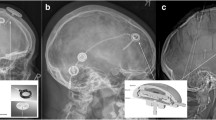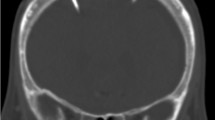Abstract
Purpose
Repeated intracranial pressure (ICP) measurements are essential in treatment of patients with complex cerebrospinal fluid (CSF) disorders. These patients often have a long surgical history with numerous invasive lumbar or intracranial pressure monitoring sessions and/or ventriculoperitoneal (VP) shunt revisions. Telemetric ICP monitoring might be an advantageous tool in treatment of these patients. In this paper, we evaluate our experience with this technology in paediatric patients.
Methods
During a 4-year period, we implanted telemetric ICP sensors (Raumedic NEUROVENT-P-tel) in 20 paediatric patients to minimise the number of future invasive procedures. Patients were diagnosed with hydrocephalus, idiopathic intracranial hypertension (IIH) or an arachnoid cyst. Most patients (85%) had a VP shunt at the time of sensor implantation.
Results
In total, 32 sensors were inserted in the 20 patients; the cause of re-implantation was technical malfunction of the implant. One sensor was explanted due to wound infection and one due to skin erosion. We experienced no complications directly related to the implantation/explantation procedures. A total of 149 recording sessions were conducted, including 68 home monitoring sessions. The median implantation period was 523 days with a median duration of clinical use at 202 days. The most likely consequence of a recording session was non-surgical treatment alteration (shunt valve adjustment or acetazolamide dose adjustment).
Conclusion
Telemetric ICP monitoring in children is safe and potentially decreases the number of invasive procedures. We find that telemetric ICP monitoring aids the clinical management of patients with complex CSF disorders and improves everyday life for both patient and parents. It allows continuous ICP measurement in the patient’s home and thereby potentially reducing hospitalisations, leading to significant cost savings.



Similar content being viewed by others
Abbreviations
- ICP:
-
Intracranial pressure
- CSF:
-
Cerebrospinal fluid
- Acetazolamide:
-
Carbonic anhydrase inhibitor, sales name: Diamox
- IIH:
-
Idiopathic intracranial hypertension
- MRI:
-
Magnetic resonance imaging
- ETV:
-
Endoscopic third ventriculostomy
- MOH:
-
Medication overuse headache
- BMI:
-
Body mass index
- LPO:
-
Lumbar puncture opening pressure
References
Lilja A, Andresen M, Hadi A, Christoffersen D, Juhler M (2014) Clinical experience with telemetric intracranial pressure monitoring in a Danish neurosurgical center. Clin Neurol Neurosurg 120:36–40. https://doi.org/10.1016/j.clineuro.2014.02.010
Norager NH, Lilja-Cyron A, Bjarkam CR, Duus S, Juhler M (2018) Telemetry in intracranial pressure monitoring: sensor survival and drift. Acta Neurochir 1:1–8. https://doi.org/10.1007/s00701-018-3691-9
Lilja-Cyron A, Kelsen J, Andresen M, Fugleholm K, Juhler M (2018) Feasibility of telemetric intracranial pressure monitoring in the neuro intensive care unit. J Neurotrauma 35:1578–1586. https://doi.org/10.1089/neu.2017.5589
Antes S, Tschan CA, Oertel JM (2014) An operative technique combining endoscopic third ventriculostomy and long-term ICP monitoring. Childs Nerv Syst 30:331–335. https://doi.org/10.1007/s00381-013-2269-3
Schmitt M, Kiefer M, Antes S, Eymann R (2012) Detection of hidden pseudotumour cerebri behind Chiari 1 malformation: value of telemetric ICP monitoring. Childs Nerv Syst 28:1811–1813. https://doi.org/10.1007/s00381-012-1749-1
Kiefer M, Antes S, Schmitt M et al (2011) Long-term performance of a CE-approved telemetric intracranial pressure monitoring. Conf Proc IEEE Eng Med Biol Soc:2246–2249. https://doi.org/10.1109/IEMBS.2011.6090426
Beez T, Kane ÃRO, Piper ÃI et al (2016) Telemetric intracranial pressure monitoring in syndromic craniosynostosis. J Craniofac Surg 27:1032–1034. https://doi.org/10.1097/SCS.0000000000002556
Magnéli S, Howells T, Saiepour D, Nowinski D, Enblad P, Nilsson P (2016) Telemetric intracranial pressure monitoring : a noninvasive method to follow up children with complex craniosynostoses. A case report. Childs Nerv Syst 32:1311–1315. https://doi.org/10.1007/s00381-016-3023-4
Antes S, Tschan CA, Heckelmann M, Breuskin D, Oertel J (2016) Telemetric intracranial pressure monitoring with the Raumedic Neurovent P-tel. World Neurosurg 91:133–148. https://doi.org/10.1016/j.wneu.2016.03.096
Antes S, Tschan CA, Kunze G, Ewert L, Zimmer A, Halfmann A, Oertel J (2014) Clinical and radiological findings in long-term intracranial pressure monitoring. Acta Neurochir 156:1009–1019. https://doi.org/10.1007/s00701-013-1991-7
Kasotakis G, Michailidou M, Bramos A, Chang Y, Velmahos G, Alam H, King D, de Moya MA (2012) Intraparenchymal vs extracranial ventricular drain intracranial pressure monitors in traumatic brain injury: less is more? J Am Coll Surg 214:950–957. https://doi.org/10.1016/j.jamcollsurg.2012.03.004
Dimitriou J, Levivier M, Gugliotta M (2016) Comparison of complications in patients receiving different types of intracranial pressure monitoring: a retrospective study in a single center in Switzerland. World Neurosurg 89:641–646. https://doi.org/10.1016/j.wneu.2015.11.037
Ma R, Rowland D, Judge A, Calisto A, Jayamohan J, Johnson D, Richards P, Magdum S, Wall S (2018) Complications following intracranial pressure monitoring in children: a 6-year single-center experience. J Neurosurg Pediatr 21:278–283. https://doi.org/10.3171/2017.9.PEDS17360
Zhang X, Medow JE, Iskandar BJ, Wang F, Shokoueinejad M, Koueik J, Webster JG (2017) Invasive and noninvasive means of measuring intracranial pressure: a review. Physiol Meas 38:R143–R182. https://doi.org/10.1088/1361-6579/aa7256
Antes S, Stadie A, Müller S, Linsler S, Breuskin D, Oertel J (2018) Intracranial pressure–guided shunt valve adjustments with the Miethke sensor reservoir. World Neurosurg 109:e642–e650. https://doi.org/10.1016/j.wneu.2017.10.044
Freimann FB, Schulz M, Haberl H, Thomale UW (2014) Feasibility of telemetric ICP-guided valve adjustments for complex shunt therapy. Childs Nerv Syst 30:689–697. https://doi.org/10.1007/s00381-013-2324-0
Barber JM, Pringle CJ, Raffalli-ebezant H et al (2016) Telemetric intra-cranial pressure monitoring : clinical and financial considerations. Br J Neurosurg 31:300–306. https://doi.org/10.1080/02688697.2016.1229752
Andresen M, Juhler M (2014) Intracranial pressure following complete removal of a small demarcated brain tumor: a model for normal intracranial pressure in humans. J Neurosurg 121:1–5. https://doi.org/10.3171/2014.2.JNS132209
Willer L, Jensen RH, Juhler M (2010) Medication overuse as a cause of chronic headache in shunted hydrocephalus patients. J Neurol Neurosurg Psychiatry 81:1261–1264. https://doi.org/10.1136/jnnp.2009.198101
Xu DS, Hlubek RJ, Mulholland CB, Knievel KL, Smith KA, Nakaji P (2017) Use of intracranial pressure monitoring frequently refutes diagnosis of idiopathic intracranial hypertension. World Neurosurg 104:167–170. https://doi.org/10.1016/j.wneu.2017.04.080
Yu L, Kim BJ, Meng E (2014) Chronically implanted pressure sensors: challenges and state of the field. Sensors (Switzerland) 14:20620–20644. https://doi.org/10.3390/s141120620
Jiang G (2010) Design challenges of implantable pressure monitoring system. Front Neurosci 4:2–5. https://doi.org/10.3389/neuro.20.002.2010
Du ZJ, Kolarcik CL, Kozai TDY et al (2017) Ultrasoft microwire neural electrodes improve chronic tissue integration. Acta Biomater 53:46–58. https://doi.org/10.1016/j.actbio.2017.02.010
Author information
Authors and Affiliations
Corresponding author
Ethics declarations
Conflict of interest
The authors declare that they have no conflict of interest.
Additional information
Publisher’s note
Springer Nature remains neutral with regard to jurisdictional claims in published maps and institutional affiliations.
Rights and permissions
About this article
Cite this article
Pedersen, S.H., Norager, N.H., Lilja-Cyron, A. et al. Telemetric intracranial pressure monitoring in children. Childs Nerv Syst 36, 49–58 (2020). https://doi.org/10.1007/s00381-019-04271-4
Received:
Accepted:
Published:
Issue Date:
DOI: https://doi.org/10.1007/s00381-019-04271-4




